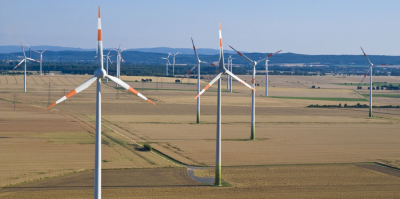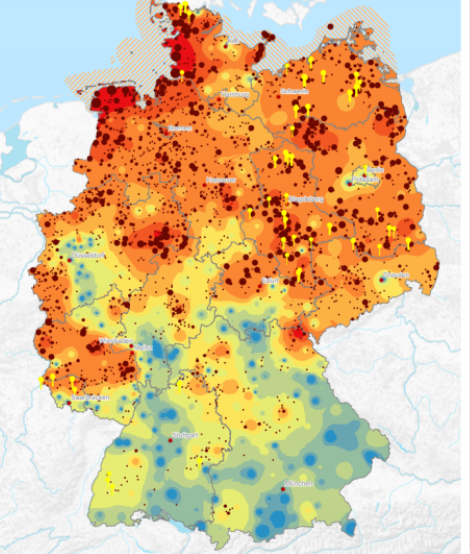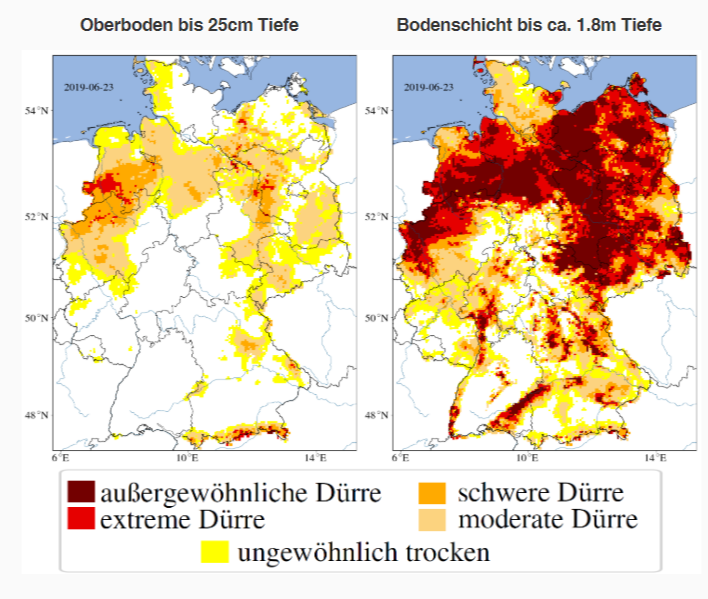Wind turbines were meant to improve the weather, now it seems these things are making it worse. Bear in mind the weather worriers are fretting about changes of a degree or two (apparently an increase of just 1.5°C means instant disaster and pumping it up by 2°C means an irreversible catastrophe).
There is already plenty of evidence to show that wind turbines are causing local nighttime temperatures to rise by as much as 1.5°C. Which would be no surprise to grape growers who use banks of large frost fans to stir up the air at nighttime, and thereby prevent frosts from forming and protect their crops.
Now a German study suggests that its 30,000 industrial wind turbines are causing droughts of the conventional kind (as in a lack of precipitation, not a lack of wind).
Pierre Gosselin has this report.
Manmade: Studies Suggest That Wind Parks Cause Climate Change, Even Regional Drought
No Tricks Zone
Pierre Gosselin
7 May 2023
Plastering the landscape with wind turbines for producing renewable energy may lead to regional drought.
Germany has so far installed over 30,000 wind turbines, which is about 1 every 11 sq. km. Plans are calling for doubling or even tripling wind power capacity. But this may be detrimental as new studies show that wind farms are altering local climates, and thus may be having an effect on global climate and contributing to regional droughts.
Northern Germany, for example, has a high concertation of wind turbines and has seen an unusual dry spell since 2019. Fortunately, recent rains have alleviated these drought conditions. Alarmist climate scientists of course blamed rising CO2 emissions for the North German drought.
Yet, a recent paper by Wang et al (2023) shows that wind farms reduce regional soil moisture, thus confirming earlier model simulations of wind-park-made climate change, e.g. by Zhou et al (2013).
German online SciFi site here reports in depth on the topic. “Climate change: Wind farms cause drought and dryness – Evidence is mounting [New study]”.
The site presents one chart depicting the wind energy installation concentration over Germany:
The North Sea region has an extremely high concentration of installed wind energy capacity. Conversely, Southern Germany has a very low concentration of installed wind energy capacity. Image: Bundesamt für Naturschutz.
Next we look at a chart depicting the ground moisture across Germany (2019). The left side shows the moisture anomaly down to a soil depth of 25 cm while the right chart shows moisture anomaly down to depth of 1.8 meters.
The legend shows, the redder the area, the drier it is. Germany’s drought happens to be worse in the regions with lots of wind turbines. Scientists suspect these turbines may be playing a role here. Image: Drought Monitor Germany.
“Is it a coincidence that the soils are driest where most wind turbines are located?” SciFi wonders.
Mounting evidence of link between drought and wind parks
In the article, SciFi examines a number of published research papers on the subject and summarizes:
As a conclusion, it can be said that it is certain that wind farms change the local climate. Very large wind farms or many wind farms also have an effect on the global climate. The results are mostly based on simulation models, whereby the study by Zhou et al. (2013), which was able to draw on comparative data, confirms the results found in the simulation models. The new study by Wang et al. (2023), which we discussed today, confirms the model calculations using real data obtained from a Chinese wind farm and shows for the first time that soil moisture is reduced by wind farms not only downwind but also upwind.
Wind farms thus contribute significantly to the drying out of soils, and to drought.”





I have suspected this might be happening, and that so called ‘Climate Change’ may have been the cover ‘they’ needed to cover this up. I am also suspicious that this could, and I repeat ‘could’ have played a part in the intensity of the Black Summer bushfires, especially in East Gippsland. The prevailing weather comes from the west / south west of Victoria, a part of the state that has, and indeed is, being raped by wind turbine ‘fan’ developers. La Niña has seen the prevailing weather come from a different direction, and has been cooler and wetter. But El Niña may see the prevailing weather return from the west / south west, which could lead to a reduction in rain in the east of the state again, as suggested in the article above in Germany. This could also lead to a higher bushfire risk in East Gippsland once more. Only time will tell. Lets see what happens next summer. It has already been suggested in the news that southern NSW is seeing drier conditions as El Niña supposedly returns. Whilst these weather patterns are normal, the construction of many more wind farms along the Great Dividing Range isn’t! This could exacerbate the fire risk in the east, and there are many, many more wind farms in the pipeline. In fact it seems to me that the wind industry will not stop until they have covered the entire Great Dividing Range with industrial scale wind turbines. Just join the dots!
Anyhow, I’m just off to switch the extractor ‘FAN’ on to clear out the steam / moisture / humidity in the bathroom! Err… is that fact not important in all of this?
Reblogged this on whatyareckon and commented:
Oh, no!!!!
As this story develops, keep in mind that NASA clearly rigged their turbine micro climate/precipitation studies back in 1976. The image in the link explains part of what took place..
https://www.facebook.com/photo/?fbid=6379955518717933&set=pcb.641950437840972
See the Steven Koonin interview on YouTube by Jordan Peterson.